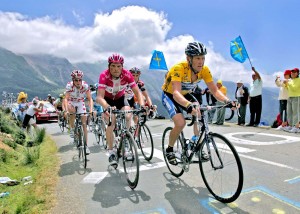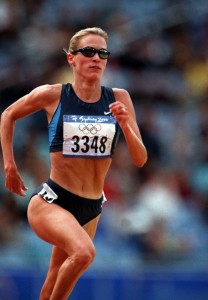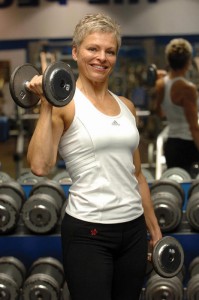For years we sports nutritionist missed the boat when it came to maximizing muscle mass because we ignored the night time decrease in muscle growth caused by post-absorptive muscle catabolism. We now know that the body is primed for growth and repair during sleep. What we must do is give the body the necessary materials it needs to do its job. Dr. Mauro Di Pasquale, M.D.
When you review the comments above by the renowned sports nutritional physiologist Dr. Mauro Di Pasquale, they imply that for some time researchers may have considered night-time catabolism’s impact on growth to be negligible and didn’t warrant attention. Those comments also imply that this reasoning may have stemmed from the fact that the problems with the body’s ability to absorb and utilize nutrients during sleep couldn’t be altered or minimized as the body simply breaks down existing muscle tissue to supply the energy needed to keep its metabolic activities going. Despite this innate back-up process, it is a process that occurs for an 8 to 9 hour time frame. The fact is that every night becomes a catabolic night of biblical proportions the minute you lay down to sleep. Catabolic processes begin there assault with a pre-programmed set of muscle destroying instructions. So precise and destructive is this catabolic activity that it naturally occurs via cyclical up-regulation of various catabolic compounds or hormones during normal sleep cycles, hence its reference to as the post absorptive muscle catabolic syndrome.
When It Rains It Pours
As a point of reference here a syndrome is defined as a set of general symptoms all occurring at the same time that collectively indicate or characterize being in a morbid (unhealthy) state. Scientifically, this internal network or place were all this muscle breakdown occurs and is converted to energy is referred to as the ubiquitin-proteasome or UPP pathway. It is here where cortisol the stress and muscle wasting hormone production is increased and accelerated as a direct result of exercise induced stress. Contrary to popular belief, the sleep cycle isn’t just a rest, repair and detoxification phase. In practical terms here, sleep becomes a survival and catabolic period to the body because of a lack of nutrients it has to work with. However, researchers now know that by the time you switch this catabolic switch off, that you have lost substantial amounts of lean muscle tissue. The other part of this axiom is the fact that you are consistently playing catch-up to promote growth. The question then becomes how can the nutrients the body needs be proved or maintained over the course of a normal sleep cycle to combat this impending catabolic syndrome before bedtime?
Understanding Post-Absorptive Physiology
Based on Dr. Pasquale’s comments above, the body is primed for growth and repair during sleep and that there are ways to counter-balance this catabolic cycle. The fact is the body has some built in mechanisms to protect itself via the release of certain hormones to minimize the impending catabolism. This could be somewhat compared to bears getting set for hibernation, when no new nutrients will be coming in for a period of time. For example, testosterone, growth hormone, and IGF-1(insulin growth factor) and insulin tend to remain elevated during sleep. These hormones guard against muscle wasting by reducing the production of cortisol and other catabolic hormones to help maintain protein synthesis. Other compounds the body calls upon include circulating glucose, fatty acids, liver and muscle glycogen (stored glucose), branch chained amino acids, glutamine and other amino acids. These sources can supply up to 1200 needed calories to slow down catabolic activity for about 12 hours. The bottom line here, maintaining your scheduled intake of nutrients throughout the day can impact night-time catabolism, especially your amino acid intake. Additionally, your carbohydrate intake replenishes lost glycogen that is stored within the liver and muscle tissue that serve as backup fuel when blood glucose levels fall. Conversely, the body uses part of your internal amino acid pool to fuel metabolic activity during sleep. If that pool is low, the body will breakdown your existing muscle tissue to support its nutritional needs.
Please Note: as a point of clarification here, to replenish glycogen stores lost during the day, they are replenished via carb intake, not protein. To replenish diminished glycogen researchers recommend a daily intake of 3 to 5 grams of carbohydrate for every pound of your body weight across the day, divided evenly with your feedings. Additionally, if you are taking a few individual amino acids like glutamine and arginine I strongly suggest that you also take a full pre-digested amino acid formula following a workout and right before bedtime.
Know Your Anabolic Hormones
As stated there are a number of hormones the body secretes to counter-act night-time muscle loss. Make no mistake about it, how adept you are at sustaining the balance and symmetry between the repeated cascade of your anabolic and catabolic hormones has a direct impact on 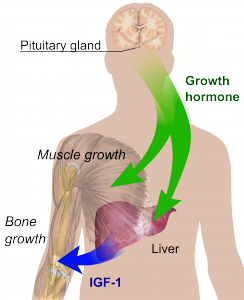 your ability to preserve muscle tissue during sleep. Having a working knowledge of the anabolic / catabolic aspects of these hormones is just prudent. For example, you have the ability to help the body accelerate the secretion of growth hormone during sleep via the intake of various amino acids (arginine, glutamine, ornithine) and other supplements. The following synopsis outlines a few of these anabolic hormones that focus on minimizing night-time muscle catabolism, as well as its acceleration.
your ability to preserve muscle tissue during sleep. Having a working knowledge of the anabolic / catabolic aspects of these hormones is just prudent. For example, you have the ability to help the body accelerate the secretion of growth hormone during sleep via the intake of various amino acids (arginine, glutamine, ornithine) and other supplements. The following synopsis outlines a few of these anabolic hormones that focus on minimizing night-time muscle catabolism, as well as its acceleration.
The Anabolic Hormones
Androgens – this class of hormones are considered male dominate hormones with testosterone being the most well-known. Androgens have a dramatic impact on muscle development. They are drawn to tiny receptors found in muscle tissue that appear to signal muscle cells to accelerate protein synthesis via a process known as androgen receptor complex binding. This process appears to turn on muscle cell DNA while also inhibiting the up-regulation of glucocorticoids like cortisol that cause muscle wasting. Androgens like testosterone also help stimulate the production of other anabolic hormones like insulin growth factor ( IGF) and growth hormone. Resistance training itself causes natural spikes in testosterone, however, lack of sleep, overtraining, stress, and sugary drinks and snacks can inhibit testosterone secretion at night. In fact data indicates that a small glucose drink can reduce testosterone production by 25%. Additionally, deficiencies of vitamin D definitively lower testosterone levels. As cited by Lee Meyer, author of Low Testosterone: By The Numbers vitamin D biologically acts more like a hormone than a vitamin, despite being referred to as the muscle vitamin. Studies have shown that when muscle receptor cells levels of vitamin D fall, decreased muscle strength and performance follow, as a direct result of its positive impact on testosterone production. Conversely, intense physical and mental stress lowers testosterone as a direct result of its down-regulation of the enzyme 11BHSD-1 located in the Leydig cells of the testes.
Stress: An Androgens Worst Nightmare
It is important to remember your body is a network of multiple deeply interconnected systems, all of which get impacted to various degrees by heavy training. Recovering from this ordeal is about more than just not lifting. It’s about giving your muscles and joints the space to heal and super-compensate, letting your nervous system calm down, and getting adequate rest. In general terms here, some researchers, especially Russian physiologist, recommend the use of adaptogens before bed and or following workout to restore order to these interconnected systems. This in essence primes the body for growth as cited above by Dr. Pasquale.Some well- known anti-stress supplements you may want to consider here include, vitamin B- complex, DHEA (dehydroepiandrosterone) , siberian ginseng and rhodiola rosea. Rhodiola has been used extensively by Russian power lifters. Research shows that this herb actually primes the system to deal with the heavier aftershocks of stress that disrupt normal metabolic processes when exercised induced stress begins to sound the alarm to internal body systems. When this occurs to help the body secretes more cortisol, which accelerates muscle tissue breakdown. It is here where rhodiola steps in to neutralize this mishap, and restore order, much like paratroopers dropped into a war zone, hence it tag as a adaptogen ( a substance that restores balance).
Please Note: to help your body maintain the anabolic potential testosterone affords, some of the most widely used supplements that stimulate testosterone production in the bodybuilding industry are: arginine, aromataste inhibitors( substances which block estrogen production) like chrysin, DHEA, long jack root. maca root, muira puama, tribulus and ZMA( zinc maganesium aspartate).
Growth Hormone (GH) – this hormone is composed of many different amino acids linked together known as peptides. Growth hormone improves the efficiency of muscle cells to take in amino acids, thus enhancing protein synthesis, muscle growth and repair. GH also regulates carbohydrate and fat metabolism, encouraging increased fat burning while preserving carbohydrates. This can have a positive impact on replenishment and maintenance of glycogen (stored glucose). Growth hormone secretions occur during exercise, however larger spikes occur during sleep, which can be improved via intake of amino acid combinations like arginine/ornithine/ lysine as well as single doses of Gaba and glutamine, about ½ hr before bedtime. Also many amino acids like arginine inhibit the actions of the catabolic hormone somatostatin which inhibits the release of glycogen, growth hormone and insulin.
Insulin Growth Factor (IGF)- IGF is a peptide hormone and helps prevent protein breakdown and plays a major role with the body’s fat-burning activities. Researchers attribute the increase in new muscle tissue you have been working hard to build to IGF, because it speeds up the activity of cells in the muscle known as satellite cells. Satellite cells appear to down-regulate the activity of the myostatin gene which is known to inhibit muscle growth. Satellite cell promote hyperplasia (the growth of new muscle tissue).
Protein and the Post Sleep Catabolic Phase
Dr. Deepak Chopra the renowned mind-body researcher reminds us that the world’s greatest chemistry set is the human body. He maintains that the vast array of botanicals studied are done so to mimic the actions of natural chemicals produced by the human body. Based on the examples thus far of the things the body calls upon to protective itself from sleep cycles of catabolism, some protein sources appear to be better suited to help and sustain anabolic activities during sleep. Casein protein and egg protein appear to better suit than whey protein to help nourish the muscles during both the pre-primed and post sleep absorptive phase of protective growth and repair. These proteins tend to break down slowly over the course of a 6 to 8 hour time frame. Whey takes about 20 minutes to reach the veins and within forty minutes your system is flooded with amino acids. Within the hour whey protein has either gone through various metabolic processes and has been synthesized (individual cells constructing various proteins). Simply put, whey can’t help sustain anabolic process during the post-sleep absorptive phase. Studies also indicate that as a direct result of increased oxidation that appears to follow the synthesis of whey protein, this limits its ability to sustain growth and repair for a substantial amount of time.
Please Note: While some oxidation is beneficial this process accelerates muscle protein breakdown during the day and night. Because of the above it may be a good idea to take a regimen of anti-oxidants (vitamins A, E, C, CoQ10, etc.) to offset this negative aspect of whey protein.
Casein and Egg Proteins Absorptive Physiology
While whey protein may afford more benefits during the course of the day, casein protein is the better choice later in the evening and at night. This due to the fact that casein, a milk protein, curdles in the stomach as it unites with various enzymes. It generally takes 3 to 4 hours before amino acids hit your blood stream to start the repair of muscle tissue. In fact in a recent study conducted by researchers in France at the University of Clermont Auvergne comparing whey to casein protein, subjects were given 30 grams of either whey or casein .  After 7 hours researchers found that with casein there was a marked decrease in protein synthesis by 31%. However, there was 27% less oxidation (degradation) of casein protein vs. whey resulting in a more sustained period of nitrogen retention. The final and most critical aspect of these numbers was a 34% decrease in muscle protein breakdown. Bottom line here, this study and countless others confirm why casein should be your protein of choice before bedtime. It helps to create and up-regulate the body’s innate post sleep anti-catabolic environment by enhancing your muscle tissues ability to neutralize the mixture of catabolic chemicals building up a head of steam toward muscle destruction, as you approach the REM stage of sleep. As a point of reference REM stands for rapid eye movement. This stage of sleep is characterized by rapid twitching of the eyes and low-voltage brain wave activity. What is important here is the fact that it is during this time most of the body’s repair cycles occur.
After 7 hours researchers found that with casein there was a marked decrease in protein synthesis by 31%. However, there was 27% less oxidation (degradation) of casein protein vs. whey resulting in a more sustained period of nitrogen retention. The final and most critical aspect of these numbers was a 34% decrease in muscle protein breakdown. Bottom line here, this study and countless others confirm why casein should be your protein of choice before bedtime. It helps to create and up-regulate the body’s innate post sleep anti-catabolic environment by enhancing your muscle tissues ability to neutralize the mixture of catabolic chemicals building up a head of steam toward muscle destruction, as you approach the REM stage of sleep. As a point of reference REM stands for rapid eye movement. This stage of sleep is characterized by rapid twitching of the eyes and low-voltage brain wave activity. What is important here is the fact that it is during this time most of the body’s repair cycles occur.
Please Note: Like whey, casein protein is derived from milk. When you purchase casein protein, make sure it isn’t listed as caseinate or calcium caseinate. These forms have been extracted before the curdling process and are actually a much lower grade of casein protein.
Egg Protein: A Medium Timed Releasing Protein
Although egg protein has taken a back seat since whey’s introduction to the market place, it is still considered one of nature’s perfect foods. Egg protein contains all of the essential amino acids in the exact proportions needed to promote the growth and maintenance of lean muscle tissue. Egg protein also has a BV of 100 ( biological value) meaning its ability to help muscles maintain nitrogen is excellent. Nitrogen is the amine portion of the amino acid NH2 intimately involved with the growth of lean muscle tissue. Egg protein also has a digestibility ratio of 97% meaning that 97% of it is absorbed as amino acids, major players in the repair process. Current data indicates that egg protein exponentially increases total muscle protein synthesis following a workout. Because of this egg serves as an key pre-priming sleep post-absorptive nutrient. Another key aspect of egg protein’s post absorptive anabolic ability is its high leucine (the key anabolic signaling amino acid) content, its impact on testosterone production and inhibition of myostatin activity ( a muscle growth inhibiting compound). For these reasons egg protein is considered a very good post sleep absorptive nutrient that will assist in maintaining your pool of amino acids, thus inhibiting night-time catabolism.
Please Note: Based on the findings presented in this report the suggestion that whey may not be all its hyped up to be, this assumption if made should be quickly down-regulated to inconsequential. Its ability to quickly flood the system with amino acids will quickly initiate muscle repair as you awake from the post sleep catabolic phase. The other aspect here surrounds whey intake before a morning workout and right afterwards. Current data indicates that as little as 10 grams of whey can jumpstart protein synthesis, as well as cited earlier flood your system with needed amino acids within 45 minutes.
Conclusions
It is important to remember that the majority of your growth occurs when you aren’t working out. The biggest mistake you could make in reaching your full anabolic growth potential is not to prepare for natural night time muscle catabolism. Helping to support the body’s attempts to maintain some semblance of its anabolic potential during sleep is the real key to sustaining growth for the long hall.
References
Andersen, L.L., Tufekovic, G., et. al., The effect of resistance training combined with timed ingestion of protein on muscle fiber size and muscle strength, Metabolism, 2005 Feb.; 54(2): 151-156.
Boirie, Y., Dangin, M., et. al., Slow and fast dietary proteins differently modulate postprandial protein accretion, Proceedings of the National Academy of Sciences (USA), 1992; 94: 14930-14935.
Chopra , D. Creating Health. Houghton Mifflin: New York. 1991.
Chromiak, J.A., Antonio, J. Use of amino acids as growth hormone- releasing agents by athletes. Nutrition. 2002 Jul; 187 (7-8): 657-661.
Dangin, M., Bione, Y., et.al., The digestion rate of protein is an independent regulating factor of postprandial protein retention, American Journal of Physiology, Endocrinology, and Metabolism, 2001; 280: E340-E348.
Goto, K., Ishii, N. et.al. The impact of metabolic stress on hormonal responses and muscular adaptations. Medical Science and Sports Exercise. 2005 Jun; 37960; 955-963.
Hackney, A.J., Bruenger, J.T., et.al., Timing protein intake increases energy expenditure 24 h after resistance training. Medicine and Science in Sports and Exercise. 2010 May; 42 95):998-1003.
Kanaley, J.A. growth hormone, arginine, and exercise, Current Opinion in Clinical Nutrition Metabolism and Care. 2008 Jan; 11 (1):50-54.
Kreider, R., et.al., Effects of whey protein supplementation with casein or bcaa and glutamine on training adaptations 1: Body composition. Medical Science and Sports Exercise. 2003; 2205: 35-5.
Miller, S.L., Tipton, K.K., et. al., Independent and combined effects of amino acids and glucose after resistance exercise, Medicine, Science, Sports and Exercise, 2003; 35(3): 449-455.
Mosoni, L., Mirand, P.P. Type and timing of protein feeding to optimize anabolism, Current Opinions in Clinical Nutrition and Metabolic Care, 2003; 6(3): 301-306.
Myer, L., Low Testosterone : By The Numbers, Amazon Digital Services: Aug. 2011.
Tang, J.E., Manolakos, J. J., et.al., Minimal whey protein with carbohydrate stimulates muscle protein synthesis following resistance exercise in trained young men. Medicine and Science in Sports and Exercise. 2007Dec.;32(60:1132-1138.
Tipton, K. D., Wolfe, R. R., Exercise, protein metabolism and muscle growth. International Journal of Sport Nutrition and Exercise Metabolism. 2001 Mar.;11(1):109-132.
Volek, J.K., Kraemer, W.J., et.al. Testosterone and cortisol in relationship to dietary nutrient and resistance exercise. Journal of Applied Physiology, 1997 Jan; 82(1); 49-54.
Wiegant, F.A., Surinova, S., et.al. Plant adaptogens increase lifespan and stress resistance in C. elegans, Biogerontology. 2009 Feb; 10 (1);27-42.
BIO
George L. Redmon PhD has been associated with the vitamin and health industry for over 25years, having served as The National Product and Education Director for one of the countries largest retailers of nutritional supplements. He has been widely published in many major bodybuilding, fitness and alternative medicine publications. He is the author of Natural Born Fat Burners, Energy for Life and is a member of The National Academy of Sports Medicine and The International Society of Sports Nutrition.
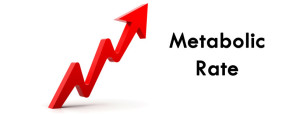 butter on a hot stove. Ok, I put the blue whale part in there. Blue whales can apparently consume half a million calories in one mouthful. Whoa. Can you say Thanksgiving buffet with every bite?! So does making those bi’s, tri’s and glutes a tad bit larger result in resting metabolism that’s copious, capacious or colossal? Or is this Much Ado About Nothing? Before I provide a teleological explanation of why this notion is cockeyed, here’s some food for thought.1, 2 According to Robert R Wolfe PhD, “every 10-kg difference in lean mass translates into a difference in energy expenditure of ~100 kcal/d.” Or in units us Americans prefer, that’s about an increase of 4.5 calories for every pound gained.2 Regardless of whether that number is entirely accurate, let’s just say RMR per unit of fat free mass is about as impressive as dunking a basketball on an 8 foot hoop.
butter on a hot stove. Ok, I put the blue whale part in there. Blue whales can apparently consume half a million calories in one mouthful. Whoa. Can you say Thanksgiving buffet with every bite?! So does making those bi’s, tri’s and glutes a tad bit larger result in resting metabolism that’s copious, capacious or colossal? Or is this Much Ado About Nothing? Before I provide a teleological explanation of why this notion is cockeyed, here’s some food for thought.1, 2 According to Robert R Wolfe PhD, “every 10-kg difference in lean mass translates into a difference in energy expenditure of ~100 kcal/d.” Or in units us Americans prefer, that’s about an increase of 4.5 calories for every pound gained.2 Regardless of whether that number is entirely accurate, let’s just say RMR per unit of fat free mass is about as impressive as dunking a basketball on an 8 foot hoop.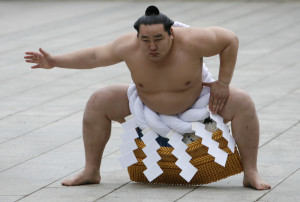
 water or electricity. Man was left to fend for itself like any other wild animal. It helped having a big brain because there was no chance in hell that humans could use physical strength or speed to kill its next meal. Conversely, humans developed quite the endurance capacity to ‘out-work’ its prey and a brain to ‘out-think’ just about every creature on Earth. You’ll notice that even modern day hunter-gatherer societies are ‘endurance’ oriented. You need endurance just to stay alive. Having large muscles serves no survival benefit.
water or electricity. Man was left to fend for itself like any other wild animal. It helped having a big brain because there was no chance in hell that humans could use physical strength or speed to kill its next meal. Conversely, humans developed quite the endurance capacity to ‘out-work’ its prey and a brain to ‘out-think’ just about every creature on Earth. You’ll notice that even modern day hunter-gatherer societies are ‘endurance’ oriented. You need endurance just to stay alive. Having large muscles serves no survival benefit. increased caloric need of 250-500 calories (according to the urban legend figure). Now where would a caveman get these calories? Would he open the fridge to get a protein shake? Go to Burger King and order a Whopper? Duh. It makes zero evolutionary sense for RMR to go up to any appreciable extent if you gain lean body mass. Or put another way. It is energetically costly to gain and maintain skeletal muscle mass. Why? Because you’d have to feed it you knucklehead. It makes evolutionary sense that it is difficult to gain muscle (which it is) and easy to gain fat (which it is). Why? So you can survive the next go round of the zombie apocalypse when an asteroid the size of Hawaii blasts Earth into a nuclear-winter oblivion. If that happens and you survive, you better pray that you have the genes for putting on fat easily. Otherwise, you and all the Victoria’s Secret models will shrivel to death in a matter of weeks.
increased caloric need of 250-500 calories (according to the urban legend figure). Now where would a caveman get these calories? Would he open the fridge to get a protein shake? Go to Burger King and order a Whopper? Duh. It makes zero evolutionary sense for RMR to go up to any appreciable extent if you gain lean body mass. Or put another way. It is energetically costly to gain and maintain skeletal muscle mass. Why? Because you’d have to feed it you knucklehead. It makes evolutionary sense that it is difficult to gain muscle (which it is) and easy to gain fat (which it is). Why? So you can survive the next go round of the zombie apocalypse when an asteroid the size of Hawaii blasts Earth into a nuclear-winter oblivion. If that happens and you survive, you better pray that you have the genes for putting on fat easily. Otherwise, you and all the Victoria’s Secret models will shrivel to death in a matter of weeks.



